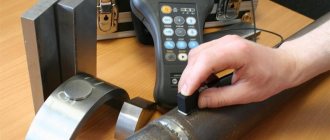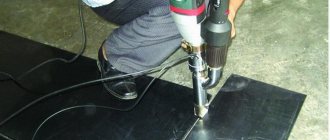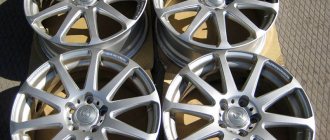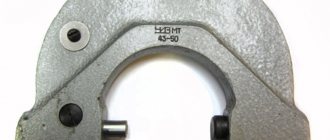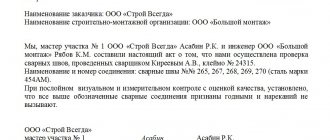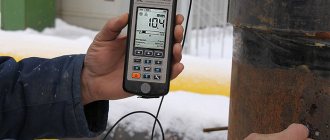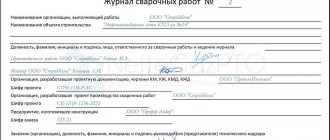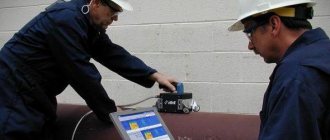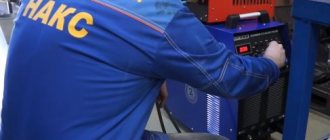Goals and objectives of non-destructive testing
Material defects accompany the part throughout its entire lifespan. They may appear: at the stage of obtaining the workpiece (defects in casting, forging or rolling); at the manufacturing stage (defects in processing, hardening); at the operational stage (fatigue cracks, brittle and ductile fracture). Manufacturing defects that are not detected in a timely manner are realized during the operation stage, leading to sudden failures, shutdowns and equipment downtime.
Numerous studies have established that parts subject to cyclic loads operate 90...97% of their service life in the presence and development of defects. Even brittle fracture does not occur instantly, but takes a certain period of time from the moment the defect arises to complete destruction. This gradual accumulation of damage in the material of the part makes it possible to monitor its condition using non-destructive testing methods. The use of these methods allows not only to detect defects, but also to assess the risk of damage and determine the cause of the defect.
Non-destructive testing (NDT) – monitoring the integrity, basic operating properties and parameters of the test object. Non-destructive testing methods ensure the detection of defects in the material of a product (object) without its destruction, through the interaction of a physical field or substance with the test object. The object most often used in non-destructive testing is a part or a connection of parts (welding seam, adhesive joint).
There is a concept of destructive control. For example, the tensile strength of a rope, bolt, or other object can only be measured by applying a crushing load, after which the object will no longer be suitable for use. Such control is applied to several objects from a batch to determine the absence of violations of technologies that affect the parameters being tested.
The tasks of non-destructive testing are related to:
- with the choice of a method suitable for detecting the most characteristic defects that arise in a given test object;
- development of methods and selection of means for monitoring;
- defining criteria for assessing the degree of damage.
Penetrant testing methods
There are several diagnostic methods:
- by applying indicators followed by visual inspection of the welding area (basic);
- using equipment that detects internal voids.
The choice of penetrant testing method depends on:
- on the load that the weld will experience;
- thickness of welded workpieces;
- type of alloy (some metals are prone to cracking and require close attention).
Non-destructive testing methods
From the point of view of physical phenomena, there are nine main types of non-destructive testing:
- magnetic;
- electric;
- eddy current;
- radio wave;
- thermal;
- optic;
- radiation;
- acoustic;
- penetrating substances.
Magnetic non-destructive testing method
Magnetic NDT methods are used to control parts and products made from ferromagnetic materials that are in a magnetized state. The properties of parts (chemical composition, structure, presence of discontinuities, etc.), which this method allows to control, are associated with the parameters of the magnetization process and the hysteresis loop. Inhomogeneities in the structure of the part, such as cavities, pores, cracks, foreign inclusions, cause changes in the magnetic flux flowing through the part. These inhomogeneities have magnetic properties that differ from the properties of the base material, which leads to a distortion of the magnetic field (Figure 134).
| Figure 134 – Scheme of the formation of a magnetic field above a defect: 1 – part being tested; 2 – crack; 3 – magnetic scattering field; N, S – permanent magnet poles | |
Main types of magnetic NDT methods:
- induction;
- magnetographic;
- magnetoresistive;
- fluxgate;
- magnetic particle.
The most widely used method is the magnetic particle method, which is used to test objects made of ferromagnetic materials with magnetic properties that make it possible to create stray magnetic fields in places of discontinuity that are sufficient to attract magnetic powder particles. The purpose of testing is to detect, by visualizing, the nature of distortions of magnetic field lines in the part being tested. Visualization of the inhomogeneity of magnetic field lines is carried out by applying magnetized particles, magnetic powders, both in the form of dry powder and in the form of a suspension, and magnetic films to the surface of the controlled part.
Magnetic particle testing is carried out in accordance with GOST 21105-87 “Non-destructive testing. Magnetic particle method."
Electrical non-destructive testing method
The electrical NDT method is based on recording the parameters of the electric field interacting with the controlled object (electrical method itself), or the field arising in the controlled object as a result of external influence (thermoelectric method). It is used for testing dielectric and conductive materials. Electrical testing methods (electrostatic powder, thermoelectric, electric spark, electric potential, capacitive) allow:
- identify defects in various materials;
- measure the thickness of walls, coatings and layers;
- sort metals by grade, control dielectric or semiconductor materials.
The disadvantages of the listed methods of electrical non-destructive testing are the need for contact with the test object, strict requirements for the cleanliness of the product surface, difficulties in automating the measurement process, and the dependence of measurement results on the state of the environment.
The primary information parameters are electrical capacitance or potential. If a current passes through a controlled part or part area, then the strength and density of the current between a pair of electrodes in contact with the surface is affected by inhomogeneities and discontinuities (Figure 135). This forms the physical basis of the electrical non-destructive testing method.
Figure 135 - Diagram of the effect of a defect on the electric potential: a) in a material without a defect; b) in a sample with a defect
Eddy current non-destructive testing method
The eddy current NDT method is based on the analysis of the interaction of an external electromagnetic field with the electromagnetic field of eddy currents induced in the test object by this field.
The eddy current method is used to detect defects, measure the electrical conductivity of materials, the thickness of coatings - to control structures made of conductive materials. The eddy current NDT method is carried out without contact between the object and the transducer - their interaction occurs at distances that ensure free movement of the transducer relative to the object. This makes it possible to obtain high-quality testing results at high speeds of the objects under study. Cracks, delaminations, sunsets, stains, cavities, non-metallic inclusions, etc. are detected. The method is suitable for detecting defects such as corrosion, wear, erosion, internal cracks, damage and thinning of walls.
The main objects of eddy current testing are electrically conductive rods, pipes, wires, sheets, railway rails, plates, coatings (including multilayer ones), reactor vessels, rollers and bearing balls, fastening parts and other industrial products.
Using eddy current non-destructive testing, discontinuities are detected that come to the surface or lie at a shallow depth, measure exact dimensions, detect vibrations, and determine the physical and mechanical characteristics and condition of objects.
The structural state of metals and alloys affects their electrical and magnetic characteristics, therefore it is possible to control the homogeneity of the chemical composition and structure of metals and alloys, and determine mechanical stresses. On the other hand, this factor may interfere with the detection of cracks and other defects.
Eddy current meters are used to sort metal materials and graphites by grade (by chemical composition). Using eddy current devices, they control the quality of thermal and chemical-thermal treatment of parts, the condition of surface layers after mechanical treatment (grinding, hardening), detect residual mechanical stresses, identify fatigue cracks in metals at the early stages of their development, etc.
Eddy current methods allow solving problems of product size control. These methods measure the diameter of wire, rods and pipes, the thickness of metal sheets and pipe walls with one-sided access to the object, the thickness of electrically conductive (for example, galvanic) and dielectric (for example, paint and varnish) coatings on electrically conductive substrates, the thickness of layers of multilayer structures containing electrically conductive layers. The measured thicknesses can vary from micrometers to tens of millimeters.
Radio wave method of non-destructive testing
Radio wave NDT methods are based on the interaction of an electromagnetic field in the wavelength range from 1 to 100 mm with the test object, conversion of field parameters into electrical signal parameters and transmission to a recording device or information processing means. Based on the nature of interaction with the test object, a distinction is made between transmitted, reflected, scattered radiation and resonant methods. Typically used to test products made from materials where radio waves are not very attenuated: dielectrics (plastics, ceramics, fiberglass), magnetodielectrics (ferrites), semiconductors, thin-walled metal objects. Methods of this type of control allow:
- determine thickness and detect internal and surface defects in products primarily made of non-metallic materials;
- measure the thickness of dielectric coatings on a metal substrate with high accuracy and productivity;
- detect defects that change both the amplitude of the wave and its phase;
- provide sufficiently complete information about the quality of foil dielectric blanks intended for the manufacture of individual layers of multilayer printed circuit boards;
- record changes in the polarization plane of a wave during its interaction with various inhomogeneities.
Thermal non-destructive testing method
The thermal monitoring method is based on remote measurement and recording of temperature fields of the outer surfaces of electrical equipment elements, apparatus and devices that are in operation under operating voltage. The method allows:
- by recalculating the measured temperature differences, assess the condition of the object being examined, identify defects that have arisen in it and determine the degree of their development;
- identify thermally inhomogeneous areas of enclosing structures and, by comparing them with design data, identify the cause of their occurrence;
- inspect objects in the infrared range of the spectrum (“thermal image”), measure the temperature at any point, observe the dynamics of thermal processes, and also create a thermal state data bank for each of the observed objects;
- conduct inspections of boiler houses and thermal stations - identify heat leaks, defects and temperature at any point in the image, obtain thermograms of equipment and pipelines;
- identify defects in brickwork and boiler linings, monitor, test and adjust combustion modes of boilers and furnaces;
- carry out quality control of insulation and tightness of products, identify areas of moisture in the structure;
- carry out tests of building envelopes with different temperature and humidity conditions.
The method is applicable to objects made of any materials. Based on the nature of the interaction of the field with the object of control, methods are distinguished: passive or self-radiation (the object is not affected by an external source of energy) and active (the object is heated or cooled from an external source). The measured information parameter is temperature or heat flow.
Optical non-destructive testing method
Visual inspection is based on observing or recording the parameters of optical radiation interacting with the test object. Visual methods are widely used due to the variety of ways to obtain primary information. The possibility of their use for external control does not depend on the material of the object. Organoleptic visual inspection allows you to detect visible defects, deviations from the specified shape, color, etc.
Visual inspection checks the quality of: preparation and assembly of workpieces, execution of seams during the welding process, finished welded joints. Determine defects in parts and structures visible to the naked eye. Visual inspection is quite informative and is the most efficient NDT method.
Visual inspection is an organoleptic method and serves as a highly effective means for preventing and detecting defects. For example, only after visual inspection and correction of unacceptable defects are welded joints subjected to control by other physical methods (X-ray, ultrasonic, capillary and other types of testing) to identify internal and surface defects.
Visual inspection using optical instruments (lenses, magnifiers, microscopes, endoscopes) is called visual-optical. Using the visual-optical method, all visible damage, marks, cracks, and burrs are identified.
Visual-optical testing, as well as visual inspection, is the most accessible and simple method for detecting surface defects in parts. Optical monitoring tools are used at various stages of manufacturing parts and during routine repair work.
Visual optical instruments include:
- for monitoring small, closely located objects (magnifying glasses, microscopes);
- for monitoring remote objects (telescopes, visual magnifiers, binoculars);
- for monitoring hidden objects (endoscopes, periscopic flaw detectors, mirrors, crawlers, etc.). When working with visual-optical inspection devices, it is necessary to correctly use the visual properties of the flaw detector.
The task of measurement control is to establish compliance with the requirements of regulatory documentation for the numerical value of the controlled parameters. Elements of measurement control can be present in any non-destructive or destructive testing method.
Measurements are carried out using instruments and tools: measuring magnifiers; calipers; metal measuring rulers; probes; goniometers; depth gauges; squares; templates, etc.
When choosing measuring instruments, they are guided by regulatory documents that indicate the required metrological indicators:
- scale division price;
- range and permissible error of measuring instruments;
- measurement limits;
- regulatory conditions of use.
Requirements for optical type control methods are established by GOST 23479-79 “Non-destructive testing. Methods of optical appearance".
Radiation methods of non-destructive testing
Radiation NDT methods are based on registration and analysis of ionizing radiation during its interaction with the controlled product. When passing through a defect and a defect-free area, different absorption of ionizing radiation occurs. The intensity of transmitted radiation will be greater in areas of smaller thickness or lower density, in particular, in places of defects - discontinuities or non-metallic inclusions.
X-ray testing is used to identify rough cracks, burns, undercuts, assess the magnitude of convexity and concavity of the weld root, unacceptable for external inspection, lack of fusion, pores, cavities, slag, oxide and other inclusions in cast and welded steel products up to 80 mm thick and in products from light alloys up to 250 mm thick.
The advantages of the radiation method of non-destructive testing are the clarity of the test results and the ability to identify small round defects (pores), which are not reliably determined by ultrasonic flaw detection.
Radiation testing allows you to detect small defects (individual pores with a diameter of 0.2...0.3 mm).
X-ray testing is the most reliable way to control welded joints and base metal when inspecting pipelines and equipment during industrial safety examinations.
The method cannot fully detect the most dangerous defects - small-opening discontinuities (cracks, lack of penetration) located at an angle of more than 7...120 to the direction of transmission (planar defects). Radiation monitoring does not allow determining the coordinates of defects.
The disadvantages of radiation methods include, first of all, the harm to humans, which requires special radiation safety measures: shielding, increasing the distance from the radiation source and limiting the time the operator stays in the hazardous area.
Radiation equipment has significant weight and dimensions (the weight of the lightest devices reaches 20 kg). Radiation monitoring is expensive - it involves the use of large quantities of radiographic films and means of chemical processing. X-ray inspection devices are characterized by high energy consumption.
Acoustic non-destructive testing method
Acoustic NDT is based on recording the parameters of elastic waves arising or excited in an object. Most often, elastic waves of the ultrasonic range are used (with an oscillation frequency above 20 kHz); this method is called ultrasonic. Elastic waves are used and recorded, the parameters of which are closely related to such properties of materials as elasticity, density, anisotropy (unevenness of properties in directions), etc.
Acoustic methods of non-destructive testing solve the following control and measurement tasks:
- the transmitted radiation method reveals deep-seated defects such as discontinuity, delamination, leaks, and solder gaps;
- the reflected radiation method detects defects such as discontinuity, determines their coordinates, dimensions, orientation by sounding the product and receiving the echo signal reflected from the defect;
- the resonance method is used mainly to measure the thickness of a product (sometimes used to detect zones of corrosion damage, missing solders, delaminations in thin places made of metals);
- The acoustic emission method detects and records only developing cracks or those capable of developing under the influence of mechanical load (qualifies defects not by size, but by the degree of their danger during operation), the method is highly sensitive to the growth of defects - it detects an increase in cracks by 1...10 µm;
- the impedance method is intended for testing adhesive, welded and soldered joints that have thin skin glued or soldered to the stiffeners;
- The free vibration method is used to detect deep defects.
Using metal ringing on impact is an old way of detecting large voids. Steel samples containing voids produce a duller and rougher sound compared to monolithic samples.
Acoustic methods are methods based on the use of elastic waves and vibrations of any frequency. Methods using frequencies from 20 kHz to 100 MHz are called ultrasonic.
The emission and reception of ultrasonic vibrations is carried out by piezoelectric transducers (finders), which are plates made of fine-crystalline (quartz, Rochelle salt) or polycrystalline ceramic materials (barium titanate, lead zirconate titanate).
Acoustic methods of non-destructive testing are divided into two large groups - active and passive methods. Active methods are based on the emission and reception of elastic waves, passive methods are based only on the reception of waves, the source of which is the controlled object itself. Passive acoustic methods are based on the analysis of elastic vibrations of waves arising in the controlled object itself.
A device that implements the ultrasonic testing method - a flaw detector - is designed to detect discontinuities and inhomogeneities in a product, determine their coordinates, sizes and nature by emitting pulses of ultrasonic vibrations, receiving and recording echo signals reflected from inhomogeneities. Figure 136 shows a schematic diagram of a pulsed ultrasonic flaw detector. The radio pulse generator 3 excites the transmitting piezoelectric crystal 1. Ultrasonic vibrations propagate in the controlled part, are reflected from its opposite wall (“bottom signal”) and enter the receiving piezoelectric crystal 2. The reflected ultrasonic vibrations excite vibrations of the receiving piezoelectric crystal 2. In this case, an alternating voltage appears on the edges of the piezoelectric crystal , which is detected and amplified in the amplifier 4, and then goes to the vertical deflection plates of the cathode ray tube (CRT) 5 of the oscilloscope.
Figure 136 – Block diagram of a pulsed ultrasonic flaw detector
At the same time, the horizontal scan generator 6 supplies a sawtooth voltage to the horizontal deflection plates of the CRT 5. The radio pulse generator 3 excites the transmitting piezoelectric crystal 1 with short pulses with long pauses between them. This allows you to clearly distinguish on the CRT 5 screen the signal of the initial (probing) pulse I, the signal from the defect III and the bottom signal II. If there is no defect in the controlled area of the part, pulse III will be absent on the oscilloscope screen. By moving the transmitting and receiving piezocrystals along the surface of the controlled part, defects are detected and their location is determined. One combined piezoelectric crystal is often used to transmit and receive ultrasonic vibrations. The contact points of the piezocrystals to the part being tested are lubricated with a thin layer of oil, gel, or petroleum jelly to ensure continuous acoustic contact with the surface of the part being tested.
Penetrant non-destructive testing method
The capillary NDT method is based on the penetration of indicator liquids (penetrants) into the cavities of surface defects invisible or weakly visible to the naked eye, having the properties of capillaries (cracks, pores, cavities, lack of fusion, intercrystalline corrosion, fistulas, etc.) and recording the resulting indicator traces visually, to determine their location, extent and orientation on the surface.
A necessary condition for identifying defects such as a violation of the continuity of a material by capillary methods is the presence of cavities that are free from contaminants and other substances that have access to the surface of objects and a depth of distribution that significantly exceeds the width of their opening. Requires trained specialists, specialized equipment, auxiliary control equipment, and places special requirements on preparing the surface of the product for inspection.
Testing by the capillary method is carried out in accordance with GOST 18442-80 “Non-destructive testing. Capillary methods. General requirements".
The capillary method is a multi-operational process. A typical list of operations includes preparing the product for inspection, applying an indicator liquid, removing its excess and displaying indicator traces of defects (Figure 137).
Figure 137 – Search for surface defects in metal using the capillary (color) method
Wetting liquids fill narrow cavities of any shape. A necessary condition for this is that the dimensions of the cavities must be so small that the liquid can form a meniscus of continuous curvature, without flat areas. Under the action of capillary forces, wetting liquids fill the cavities of cracks and other surface defects such as discontinuities in the material.
The liquid that has filled the crack cavity will be retained in it by capillary forces even if it is removed from the surface of the part. The manifestation of a crack is carried out using materials wetted by the liquid from the crack. Capillary methods are divided into two types: luminescent and color. In fluorescent flaw detection, defects are detected using luminescent penetrating liquids. Ultraviolet lamps are used for luminescence during testing. A simpler and more often used is the color inspection method, in which defects are identified using brightly colored penetrating liquids.
All non-destructive testing methods are indirect methods. Adjustment (calibration) should be carried out using control samples that simulate the measured physical parameter of the method, which could detect defects of a wide variety of nature. Each individual non-destructive testing method solves a limited range of technical control problems.
Classification of methods
PVC inspection of welded joints involves the use of various methods. They are classified according to the method of detecting defects and the type of penetrating substance. The choice depends on the scope of use and characteristics of the object under study.
The penetrating solution method is based on the use of a liquid indicator. This is a fairly common method, in demand in various industries. The essence of the filter suspension method is the formation of a certain pattern by particles of the dispersed phase.
Based on the method of identifying the pattern, methods are classified into luminescent and contrast. The first method is to fix the contrast during indicator testing. Contrast is divided into brightness and luminescent color.
To conduct research of this type, professional materials for capillary control are required. Their choice should be approached with special attention, because the effectiveness of the procedure and the likelihood of identifying defects depend on it. It is recommended to order consumables and accessories only from trusted places. Trust certified brands and reliable suppliers. These include, whose reputation and responsibility have been tested over the years.
Questions for self-control
- What are the main tasks of non-destructive testing?
- Purpose and physical basis of magnetic NC.
- Purpose and physical basis of electrical NDT.
- Purpose and physical basis of eddy current NDT.
- Purpose and physical basis of radio wave NK.
- Purpose and physical basis of thermal NDT.
- Purpose and physical basis of optical ND.
- Purpose and physical basis of radiation NDT.
- Purpose and physical basis of acoustic ND.
- Purpose and physical basis of capillary NK.
Research Process
Penetrant control is carried out in the following sequence:
- preliminary cleaning of the object under study using a professional cleaning agent;
- applying penetrant to the prepared surface;
- removal of excess substance;
- applying a special developer to the surface of the object under study.
It is important to properly prepare the research object and strictly follow the algorithm of actions. To achieve an effective result, it is necessary to use high-quality consumables and involve specialists. You will find all the necessary products on the website. We invite you to familiarize yourself with the range and order a set for non-destructive penetrant testing.
